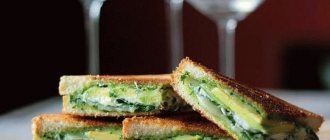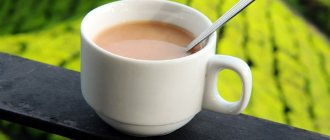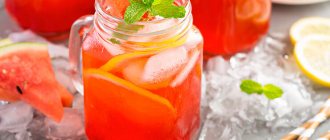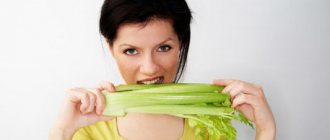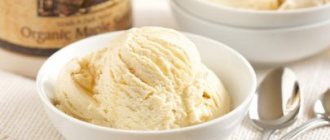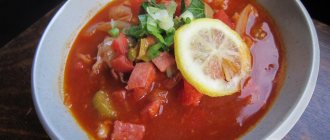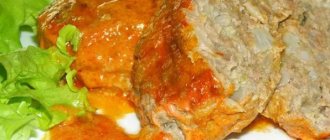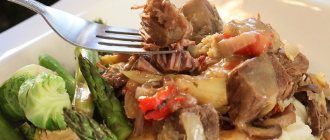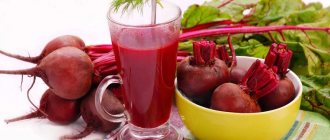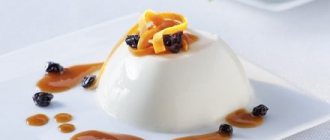What is Kalmyk tea and what is it made from?
To understand why this tea has beneficial nutritional properties, you need to understand how it came to be. Tea was used by the nomadic peoples of modern Kalmykia; it was the main source of warmth on the cold, foggy nights that the nomads spent in the open air. Researchers claim that the Mongolian tribes borrowed the recipe for the drink from Tibetan monks and then spread it throughout Central Asia.
The health benefits and harms of Kalmyk tea are hidden in the properties of the main components: green tea and milk. The remaining ingredients are additives to the main composition.
Various recipes indicate that fat, pepper, and spices are added to the drink. The basic recipe for Kalmyk tea involves preparing it with salt. Some methods involve the addition of medicinal herbs.
Name and origin
This drink originated among nomadic peoples.
They were always on the move and spent a lot of time in the saddle. That's why they needed such tea - strong, salty, invigorating and satisfying hunger. Most likely, it was invented by the Mongols, who, having received traditional tea from China, began to prepare it according to completely different recipes. Today it is enjoyed with pleasure in many Asian countries, Tibet, the Caucasus and the southern regions of Siberia. What is the salty tea called? Most often you can hear it called Kalmyk, Mongolian, Tibetan or Kyrgyz. You can also find the names “domba” or “dzhomba”. The Uighurs call this drink atkanchay. And in Tibet it is better known as chasuima.
Every nation that considers this drink national has legends about its wonderful properties. According to beliefs, it is able to heal from fatal illnesses and serious illnesses, give strength for a long journey and battle with the enemy, and warm even in the most severe frost.
Composition and benefits of Kalmyk tea
Green tea differs from classic black tea in the extraction method, which is why their beneficial properties differ.
Green tea is rich in substances classified as flavonoids. Contains ascorbic acid, a group of beneficial minerals. It is a powerful antioxidant that benefits the body when consumed.
Milk can be anything. It is useful to use coconut, goat, and soy milk.
We recommend reading: The benefits and harms of coconut milk for the body
Kalmyks traditionally prepare tea based on cow's milk. The benefit of this method is the ability to saturate the body. Milk is rich in calcium, potassium, magnesium. It contains useful phosphates. Butter is rich in carbohydrates, proteins and B vitamins.
The calorie content of 100 g of Kalmyk tea is 250 kcal. It is believed that adding oil to a drink may be harmful to those who monitor their cholesterol levels. But the recipe for classic Kalmyk tea does not imply abstinence from fat; the tea’s ability to saturate the body is based on this additive.
Beneficial properties of Kalmyk tea
Tea leaves have the beneficial property of providing a tonic effect and increasing the mental activity of the body. Green tea is used for weight loss because it helps improve metabolic processes and prevents the accumulation of fat. This property is valued when creating diets and detox programs.
Milk enriches the body with calcium, and the vitamin complex helps improve immunity.
Flavonoids have a positive effect on hematopoietic processes, help increase the elasticity of vessel walls, and influence blood clotting.
The benefits of the drink during the cold season are explained by its richness in spices and nutrients. It has the property of warming and having an anti-inflammatory effect.
Green tea is known for improving the functioning of the heart muscle and preventing the risk of heart attacks and strokes.
It is recommended to drink it for pyelonephritis, because it has a mild diuretic effect.
Combining green tea with milk is beneficial for the digestive system; this tandem helps remove harmful toxins from the body. This beneficial property is used to cure inflammation of the gastrointestinal tract.
Is Kalmyk tea good for nursing mothers?
Eastern medicine recognizes the benefits of Kalmyk tea with milk for nursing mothers. Kalmyk tea based on milk with the addition of a minimal amount of spices is recommended to increase lactation. The mechanism of action is based on a combination of beneficial substances that affect milk flow.
Many mothers use special tea compositions if they experience difficulties with feeding. Tea will not cause harm, but will only bring benefits if properly prepared and used carefully.
We recommend reading: Mint tea: beneficial properties and contraindications, how to make
Recipes for making a real tasty drink
Among the recipes for this delicious Tibetan drink, there are both ancient ones, which are considered classic, and new ones, created in modern times experimentally. Their composition is modified due to the fact that it is not always possible to get the necessary ingredients.
Read also: Curd dough for apple pie
Whichever one you choose, it is worth knowing that accuracy and a certain procedure are important here.
Ingredients for the traditional method:
- pressed tea (for example, pu-erh) green or black – 75 grams;
- salt – 1 teaspoon;
- yak milk – 6 glasses;
- yak melted butter – 1 cup.
The tea will be nutritious and tonic if you follow the following sequence when preparing:
- You need to take any thick pot or cauldron and pour milk into it. As soon as it starts to boil, add a tea briquette and cook for at least half an hour, remembering to stir. The fire should be low so that the milk does not run away and foam.
- When the tea is boiled, strain, add salt and oil to it. After this, beat well. In Tibet, they used “donmo”, a special mixing vessel, for this purpose. But since not everyone can find it in their home now, a regular mixer is ideal. During the process, the consistency of the tea should become uniform and thick. It will look more like a cocktail. After this, Tibetan tea can be poured into mugs and tasted.
Yak is a rare animal, so its milk and butter are most often replaced with cow's milk, only with a high degree of fat content. And in many modern recipes, in addition to this, ordinary black (green) classic large-leaf tea without pressing is simply brewed in water, then all the ingredients are added and blended in a blender.
Rules for preparing Kalmyk tea
Making tea is a special procedure, similar to a national ritual. The classic tea recipe involves gradual infusion over several hours. The modern classic recipe takes into account the peculiarities of everyday life in the 21st century. If several centuries ago Kalmyk tea was prepared exclusively from pressed tea tiles, today they use large leaf tea leaves.
The benefit of Kalmyk tea bags lies in its simplicity for those who do not have free time. Manufacturers make tea leaves containing milk powder. Only spices are added to this drink and infused for 10 - 15 minutes. True connoisseurs of Kalmyk tea believe that this method minimizes the benefits of consumption.
A distinctive feature of the national brewing method is the process of oxygenation. To do this, stir the liquid constantly, scoop out portions of water and pour it back, lifting it above the edge of the container.
Interesting! Followers of traditions claim that this technique must be repeated 46 times, only in this case the tea will be beneficial.
How to brew Kalmyk tea at home
To make your own, you can use cream or milk. The formula for calculating the components must take into account the number of guests. It is not customary to heat tea; it is drunk freshly prepared to enjoy the taste and benefit from the ingredients.
Pieces of yeast dough prepared in advance are served with tea.
Classic Kalmyk tea
Self-preparation is carried out using tea leaves or slab tea.
- 200 g of tea leaves are poured into 2 liters of cold water, placed on the stove, brought to a boil, reduced heat, and simmered under the lid for 15 minutes.
- Add 1.5 liters of cream to the drink and cook for 10 minutes.
- Add 50 g of butter to the mixture.
- Salt and pepper are also added.
- Remove from heat, leave under closed lid for 5 - 10 minutes.
Before pouring the drink into cups, add a pinch of nutmeg. Drink hot, add oil if desired
Kalmyk tea with milk
You can use any type of milk to make tea. Soy and coconut milk are taken in the same quantity as water for brewing. The higher the fat content of the milk, the smaller its volume.
Jomba with black tea
You can often find other names; tea is often called Jomba. This name is mentioned by A. Pushkin in his travel notes. Fans of increased strength use black leaves for brewing, which have a more pronounced tonic effect and have an invigorating effect. Black tea contains caffeine, which may be harmful to people with high blood pressure.
Jomba with green tea
Green leaf jomba is a classic recipe. Slab tea is cut with a knife and then pounded until softened. Only after this the cooking process begins. This tea is not easy to find; it is sold in markets in specialized tea pavilions. Tiled tea should not be stored for more than 3 years from the date of pressing: brewing can be harmful due to the release of esters.
Jomba with green and black tea
Some peoples, immigrants from Mongolia, have preserved recipes for mixing two types of tea leaves. A mixture of green and black teas produces a special invigorating effect. However, such a drink is not useful for everyone, since it can harm the cardiovascular system due to the caffeine content.
Thick Kalmyk tea
The thickness of the drink is given by high-fat cream and the addition of wheat flour. The longer you brew Kalmyk tea, the thicker it becomes. Initially, the drink was supposed to quench not only thirst, but also hunger, so those who are familiar with this drink perceive it as a first course.
Famous brands and manufacturers
Mongolian (Kalmyk) teas are available for sale in the “3 in 1” format. This means that they contain green tea, milk powder and salt, and they are very easy to brew.
Among the famous brands of teas:
- “Mongolian with milk” (manufacturer - Art Life) – 20 bags of 6 g each, a combination of green and black tea, nutmeg;
- “Haanchai”, “Ogedei Khan Tea” (produced in Malaysia, Singapore, Russia) - 30 bags of 12 g each, made from premium green tea, with iodized salt;
- “Khaanchai with pepper” - a warming drink for gourmets, 30 bags of 12 g each;
- “Arshan” (Kalmyk tea) – made from green and black tea, with iodized salt;
- “Jomba” (Kalmyk tea) – with the addition of nutmeg extract, which gives a piquant taste;
- “Bator” is made from premium green tea with additives traditional for Mongolian teas.
Our publication will tell you about the benefits and harms of tea with thyme, how to brew it correctly, when and how much to drink.
What is yellow tea from Egypt and how is it drunk? The answers are here: https://chay-i-kofe.com/chay/vidy/zheltiy/zheltiy-chay-iz-egipta/
How to make Kalmyk tea even healthier
To increase the beneficial properties of tea, medicinal herbs or parts of plants are added, which increase the benefits of consumption:
- bitter almond leaves (have the property of having an antimicrobial effect);
- grape seeds (give a rich shade, have the beneficial property of increasing the body’s defenses);
- rosehip flowers (improves the shade, adds a unique tartness to the taste, useful for use during the cold season).
We recommend reading: Rosehip infusion: benefits and harms, how to prepare
Traditional additives include pepper, nutmeg, bay leaf, and cloves. Spices have the property of having a positive effect on the parts of the brain responsible for mental and physical activity. From a photo of Kalmyk tea you can determine whether auxiliary components have been added or whether it is brewed using water and milk.
Harm of Kalmyk tea and contraindications for use
The harm of Kalmyk tea can be assessed depending on the composition, method of preparation and the state of human health.
Strongly brewed tea based on a mixture of green and black leaves is harmful to those who have difficulty normalizing blood pressure: it has a stimulating effect on the nervous system. It is harmful to drink this tea at night for people suffering from insomnia.
If you are lactose intolerant, tea will be harmful if it is brewed with cow's milk.
It is recommended with caution to children under 3 years of age: its action carries the risk of harm to the digestive system that has not yet formed.
Contraindications and side effects
Herbal drinks are beneficial and will help speed up your recovery. But not everyone can accept them. People with individual intolerance should not be treated with teas. Do not give drugs to children under 3 years of age. The formulations should be used with caution during pregnancy and breastfeeding.
Each plant has restrictions on its use, and these must be taken into account before starting therapy:
- Products containing licorice are prohibited for use by people with hypertension and children. Inappropriate use of medications is fraught with disruptions in the functioning of the heart and urinary system, fluid retention in the body, and cephalgia.
- Strawberries are a plant allergen, so you should not take infusions with them if you are prone to allergies, otherwise itching, redness and hyperemia of the skin will appear. Possible deterioration of general condition.
- People with stomach ulcers, gastritis with high acidity, or mental disorders should not drink chamomile tea for coughs.
- Tea with marshmallow is contraindicated for diabetics.
- The use of linden potions is not recommended for heart failure.
- People with hypotension and varicose veins should not be treated with mint infusions.
- Tea with cumin is prohibited for use by patients suffering from gastric and duodenal ulcers, cholelithiasis, hyperacid gastritis, and diabetes.
- Ginger medicines should not be used for cirrhosis, gastric ulcers and hypertension.
